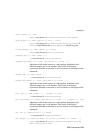rcontrol(1)
start command, the server argument and the name of the server. The command
rinfo (with the -s flag) can be used to show the status of the RMS servers.
To instruct an RMS server to change its reporting level, use the reload command and
the server argument with the name of the server. In addition, you should specify the
attribute debug and a value. RMS servers write their log files to the directory
/var/rms/adm/log on the rmshost. See Section 9.6.
# rcontrol stop server = mmanager
# rcontrol start server = mmanager
# rcontrol reload server = mmanager debug = 1
Managing Resources
To instruct the scheduler to suspend the allocation of CPUs to a resource request, use
rcontrol with the suspend command followed by either the name of the resource or
the batch system’s identifier for the request. This suspends jobs running on the allocated
CPUs and decrements the user’s CPU usage count.
# rcontrol suspend resource = 2234
# rcontrol suspend batchid = 14
Note that a resource request that has been suspended by an administrative user cannot
be resumed by its owner.
To instruct the scheduler to resume the allocation of CPUs to a resource request, use
rcontrol with the resume command followed by either the name of the resource or the
batch system’s identifier for the request. This reschedules jobs that were running on the
allocated CPUs, unless doing so would cause the user’s CPU usage limit to be exceeded.
# rcontrol resume resource = 2267
# rcontrol resume batchid = 384
To instruct RMS to send a signal to the jobs running on an allocated resource request,
use rcontrol with the kill command followed by either the name of the resource or
the batch system’s identifier for the request. This kills the jobs running on the allocated
CPUs (by sending the signal SIGKILL to each process). The optional attribute signal
can be used to send a specific signal. For example, to send the signal SIGTERM:
# rcontrol kill resource = 9835 signal = 15
# rcontrol kill batchid = 396 signal = 15
To instruct the scheduler to change the priority of a resource request, use rcontrol
with the set command and the resource argument followed by either the name of the
resource or the batch system’s identifier for the request. In addition, you should specify
the attribute priority and the new value. Priority values range from 0 to 100 (default
50).
5-26 RMS Commands


















